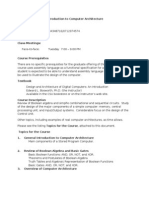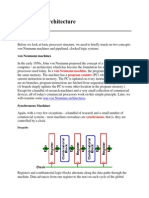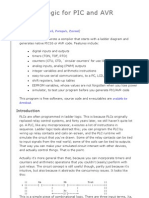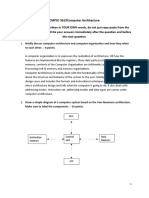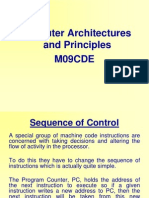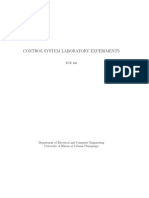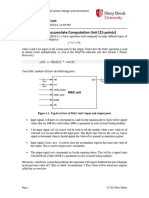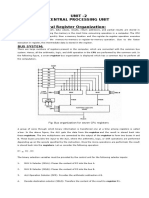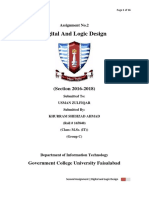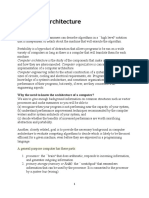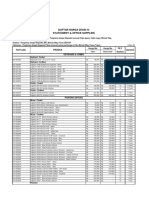Embedded Systems 220 Control Unit Design Notes: PC: PC + 1 PC: PC PC: Operand PC: PC + Operand
Embedded Systems 220 Control Unit Design Notes: PC: PC + 1 PC: PC PC: Operand PC: PC + Operand
Uploaded by
Mahesh JangidCopyright:
Available Formats
Embedded Systems 220 Control Unit Design Notes: PC: PC + 1 PC: PC PC: Operand PC: PC + Operand
Embedded Systems 220 Control Unit Design Notes: PC: PC + 1 PC: PC PC: Operand PC: PC + Operand
Uploaded by
Mahesh JangidOriginal Title
Copyright
Available Formats
Share this document
Did you find this document useful?
Is this content inappropriate?
Copyright:
Available Formats
Embedded Systems 220 Control Unit Design Notes: PC: PC + 1 PC: PC PC: Operand PC: PC + Operand
Embedded Systems 220 Control Unit Design Notes: PC: PC + 1 PC: PC PC: Operand PC: PC + Operand
Uploaded by
Mahesh JangidCopyright:
Available Formats
Embedded Systems 220 Control Unit Design Notes The von Neumann architecture is the design of a CPU that
consists of an arithmetic logic unit, a control unit, memory, and input and output devices. The innovation in this design is the idea to have the control unit decode instructions from memory, rather than follow some fixed pattern. The control unit is just like the ALU, with the exception that its accumulator (the program counter) controls the flow of the program. You should design your control unit using the same basic idea that you use for the ALU. That is, you should determine which functional modules you need, and connect these to a multiplexer. The only difference is that unlike the ALU, you cannot just use the opcode for the multiplexer input. Rather, you will need to implement some instruction decoding logic. As an example, we shall be designing a control unit for the following set of instructions. 00 xx 01 vv 02 vv 03 vv 04 aa 05 dd 06 aa 07 dd Halt the CPU (pc := pc). Load an immediate value into the accumulator (acc := vv). Add an immediate value to the accumulator (acc := acc + vv). Subtract an immediate value from the accumulator (acc := acc vv). Branch to the specified address (pc := aa). Branch by the specified distance (pc := pc + dd). If the accumulator is zero, branch to the specified address (pc := aa). If the accumulator is zero, branch by the specified distance (pc := pc + dd).
The first step is to examine these instructions and produce a complete list of arithmetic operations that can be performed on the program counter. Do not forget to include pc := pc + 1 for those instructions that do not branch anywhere. In fact, your design will be simpler if this if the first arithmetic operation in your list. 00 01 10 11 pc := pc + 1 pc := pc pc := operand pc := pc + operand
You should number each operation. Use binary numbers. Following the typical design of an ALU, you should design your CU by building the above four functional blocks and then wiring them into a multiplexer according to the numbers you gave them. You should not treat aa and dd as being something separate. They should be connected to a register containing the operand of the instruction.
Jason Foo [foo-jr@ee.uwa.edu.au]
Page 1 of 3
The next step is to design the logic that generates the two-bit input to the multiplexer. This part of the circuit is called the instruction decoder. We shall refer to the multiplexer inputs as y1 and y0. The instruction decoder should be designed by constructing a truth table. The inputs should be the opcode (x2x1x0) and any condition codes. In this circuit, there is only one condition code, which is the =0 condition (x3). The outputs are y1y0. There are two output bits, so you will be generating two Boolean functions. You could construct the truth table entirely in binary and reduce it using Karnaugh maps or the Quine-McCluskey algorithm. However, RETRO provides nice decoder blocks (the =c blocks), so we shall be writing decimal numbers into our truth table. x3 x x x x x x 0 1 0 1 x2x1x0 0 1 2 3 4 5 6 6 7 7 y1y0 01 00 00 00 10 11 00 10 00 11
The xs in the table are dont care states. To generate the above table, you need to go through each opcode, and decide which of your four PC operations applies. You only need to consider condition codes for opcodes that are dependent upon the condition. You should construct the logic for y1 and y0 separately. They are two separate Boolean functions. The resulting circuit is shown below.
Jason Foo [foo-jr@ee.uwa.edu.au]
Page 2 of 3
Most CPUs address memory in bytes. However, instructions are often larger than a single byte. In our example, the instructions are two bytes long. The control unit needs to be able to step from the first byte to the next, as well as perform branching. A signal from the timing signal generator indicates whether we are stepping or branching. We need to use a one-bit multiplexer for this switch.
Two parts of the control unit are yet to be designed. The first part is the need for two registers to fetch instructions. These registers have not been shown here. The second part is the timing signal generation. There is no straightforward approach to designing the timing signals. Rather, you should try to understand what needs to happen during each clock cycle, and how the timing signals control this. For most CPUs, in each clock cycle, you need to: 1. 2. 3. 4. 5. 6. 7. Load the opcode register (Brunls diagrams call this CODE). Increment the program counter. Load the operand register (Brunls diagrams call this ADDRESS). Wait for effective address calculations to fall through to the address bus. Wait for calculation results to fall through to the data bus. If the instruction writes to a register, then load that register. If the instruction writes to memory, then perform the memory write. Increment/branch the program counter.
There are two types of timing signal. Some are square hat pulses, that clock risingedge triggered components, such as registers. Others are high or low for extended periods of time. These switch multiplexers, and are high for the exact period of time necessary for other signals to clock rising-edge triggered components. You need to look at the timing diagram in the lecture notes, and think about it until you understand what each signal is doing. Think about it in terms of what happens in what order during a clock cycle. You need to do this on your own to understand it.
Jason Foo [foo-jr@ee.uwa.edu.au]
Page 3 of 3
You might also like
- 4-Bit AluDocument45 pages4-Bit AluAllam Rajkumar0% (1)
- Neo KicksDocument19 pagesNeo Kicksapi-3703652No ratings yet
- Quanta ZAAR Rev 3ADocument47 pagesQuanta ZAAR Rev 3AAhmed OsmanNo ratings yet
- Q.1) A) - Explain (1) ALU: DefinitionDocument16 pagesQ.1) A) - Explain (1) ALU: DefinitionAmee PandyaNo ratings yet
- Introduction To Computer ArchitectureDocument23 pagesIntroduction To Computer ArchitectureLwanga Charles Chas100% (1)
- IT225: Computer Organizations: August 25, 2014 (Monday)Document12 pagesIT225: Computer Organizations: August 25, 2014 (Monday)skiloh1No ratings yet
- Lab1 SpecDocument6 pagesLab1 Spec星期三的配音是對的No ratings yet
- Cpu DesignDocument11 pagesCpu DesignnatyNo ratings yet
- Computer Architecture: Processor StructureDocument6 pagesComputer Architecture: Processor StructureEiEiPustaNo ratings yet
- Arithmetic Logic UnitDocument2 pagesArithmetic Logic UnitENGLISH CLASSESNo ratings yet
- Ladder Logic For PIC and AVRDocument9 pagesLadder Logic For PIC and AVRCarlos Cesar MaiaNo ratings yet
- Arithmetic Logic Unit: From Wikipedia, The Free EncyclopediaDocument5 pagesArithmetic Logic Unit: From Wikipedia, The Free Encyclopediahotboy7245No ratings yet
- Coa MidDocument7 pagesCoa Midmulugetahiluf995No ratings yet
- Architecture 2020Document10 pagesArchitecture 2020honey arguellesNo ratings yet
- Lab Project: Shift-and-Add Multiplication Circuit With StorageDocument5 pagesLab Project: Shift-and-Add Multiplication Circuit With StoragesneophNo ratings yet
- Unit-1 CoaDocument26 pagesUnit-1 CoaArun KrishNo ratings yet
- Mcs 012 PDFDocument397 pagesMcs 012 PDFIshan TiwariNo ratings yet
- Lab1 15Document5 pagesLab1 15Eng:ehab AlmkhlafiNo ratings yet
- Software Stage EDocument19 pagesSoftware Stage ETim TaylorNo ratings yet
- Arithmetic Logic Unit (ALU)Document11 pagesArithmetic Logic Unit (ALU)Ryan MaulanaNo ratings yet
- Eee342 Lab1 ManualDocument7 pagesEee342 Lab1 ManualFaruk SöndürülmezNo ratings yet
- Eee342 Lab1 ManualDocument7 pagesEee342 Lab1 ManualDenizNo ratings yet
- Lectures Section 3 ModifiedDocument73 pagesLectures Section 3 ModifiedcoventryUkNo ratings yet
- Project Report About MultipliersDocument62 pagesProject Report About Multiplierssenthilvl80% (5)
- Assignment 5 CSDocument15 pagesAssignment 5 CSAbelbeen ethioNo ratings yet
- Disc 2Document42 pagesDisc 2NagamaniNo ratings yet
- EE 222 Assignment No 1Document17 pagesEE 222 Assignment No 1Ahmed Razi UllahNo ratings yet
- DSPACE Procedure With MPPT ExampleDocument21 pagesDSPACE Procedure With MPPT ExampleSri SriNo ratings yet
- Calculator: Jump To Navigation Jump To SearchDocument12 pagesCalculator: Jump To Navigation Jump To SearchDexterNo ratings yet
- D 32-CPU: Esign of A Bit Single CycleDocument11 pagesD 32-CPU: Esign of A Bit Single CycleAritra GuptaNo ratings yet
- ArchitectureDocument112 pagesArchitectureKrishnaveni DhulipalaNo ratings yet
- Milestone 2-UpdatedDocument13 pagesMilestone 2-UpdatedHưng Nguyễn ThànhNo ratings yet
- MCS-012 Block 1Document103 pagesMCS-012 Block 1Abhishek VeerkarNo ratings yet
- ECE486 Lab ManualDocument106 pagesECE486 Lab ManualDR ARINDAM SENNo ratings yet
- Computer ArchitectureDocument19 pagesComputer ArchitectureediealiNo ratings yet
- Coa Unit - 1 Important QuestionsDocument10 pagesCoa Unit - 1 Important QuestionskarthikanegofficialNo ratings yet
- Tutorial ProjectDocument16 pagesTutorial ProjectMuhammadNizarArifansyahNo ratings yet
- Hardwired ControlDocument6 pagesHardwired Controlapi-19967001No ratings yet
- Milestone2 Ee3043Document14 pagesMilestone2 Ee3043teoNo ratings yet
- Arithmetic Logic UnitDocument11 pagesArithmetic Logic UnitPrasanna Kumar VotarikariNo ratings yet
- ECN 252 Lab 9 Design Using VHDLDocument1 pageECN 252 Lab 9 Design Using VHDLGajananNo ratings yet
- Labsheet 1: Problem 1: Subtractor DesignDocument4 pagesLabsheet 1: Problem 1: Subtractor Designanon_248257978No ratings yet
- Ch01 Basic Concepts and Computer EvolutionDocument36 pagesCh01 Basic Concepts and Computer EvolutionMark ShanNo ratings yet
- Ladder Logic For PIC and AVRDocument6 pagesLadder Logic For PIC and AVRTomás Totaro100% (1)
- Digital Calulator Using 89C52 Micro ControllerDocument8 pagesDigital Calulator Using 89C52 Micro Controllerchachunasayan75% (4)
- Computer Architecture 2 MarksDocument32 pagesComputer Architecture 2 MarksArchanavgs0% (1)
- Proj Part1Document8 pagesProj Part1Likhitha LikkyNo ratings yet
- COA Unit-3Document22 pagesCOA Unit-3Tanisha JainNo ratings yet
- Lab IV Lecture 2: Step 1 Review Introduce Step 2 Course Web PageDocument38 pagesLab IV Lecture 2: Step 1 Review Introduce Step 2 Course Web PageKulanthaivelu RamaswamyNo ratings yet
- Lecture 12: More On Registers, Multiplexers, Decoders, Comparators and Wot-NotsDocument5 pagesLecture 12: More On Registers, Multiplexers, Decoders, Comparators and Wot-NotsTaqi ShahNo ratings yet
- DP 2 SolDocument14 pagesDP 2 Solchanuka469No ratings yet
- Cad For Vlsi 2 Pro Ject - Superscalar Processor ImplementationDocument10 pagesCad For Vlsi 2 Pro Ject - Superscalar Processor ImplementationkbkkrNo ratings yet
- Unit - 2 Central Processing Unit TOPIC 1: General Register OrganizationDocument13 pagesUnit - 2 Central Processing Unit TOPIC 1: General Register OrganizationRam Prasad GudiwadaNo ratings yet
- Calculator: Mechanical Calculator Calculator (Disambiguation)Document8 pagesCalculator: Mechanical Calculator Calculator (Disambiguation)Jef PerezNo ratings yet
- 1.4.1 CPU ArchitectureDocument11 pages1.4.1 CPU ArchitectureAbbas HaiderNo ratings yet
- Lab 6Document7 pagesLab 6Koteswara Rao VaddempudiNo ratings yet
- DLD Second Assignment (15-FEB-17)Document16 pagesDLD Second Assignment (15-FEB-17)Adil aliNo ratings yet
- Computer Architecture NotesDocument53 pagesComputer Architecture Notesdrusilla bagaboNo ratings yet
- ATMEGA8 Expt 1Document2 pagesATMEGA8 Expt 1कुलदीप पुरोहितNo ratings yet
- Exp - 08 Flight86Document6 pagesExp - 08 Flight86Muhammad SaqibNo ratings yet
- The Elements of Computing Systems, second edition: Building a Modern Computer from First PrinciplesFrom EverandThe Elements of Computing Systems, second edition: Building a Modern Computer from First PrinciplesNo ratings yet
- Preliminary Specifications: Programmed Data Processor Model Three (PDP-3) October, 1960From EverandPreliminary Specifications: Programmed Data Processor Model Three (PDP-3) October, 1960No ratings yet
- FSMF Wcdma Ru50ep1Document10 pagesFSMF Wcdma Ru50ep1Andrei GhitiuNo ratings yet
- Red HatText Linux 7 Migration Planning Guide en USDocument80 pagesRed HatText Linux 7 Migration Planning Guide en USvisha_sNo ratings yet
- Digital Indicating Controller: Db1000 SeriesDocument8 pagesDigital Indicating Controller: Db1000 SeriesChoirul MutamamNo ratings yet
- Catalog 1295925818Document32 pagesCatalog 1295925818Guillermo Garcia0% (1)
- Using OpNetDocument5 pagesUsing OpNetMalebogo BabutsiNo ratings yet
- Dynaudio Passa 3C BuildDocument20 pagesDynaudio Passa 3C BuildSoca AlexandruNo ratings yet
- 7 Chapter 3-MCEGoldDocument60 pages7 Chapter 3-MCEGoldPapun ScribdNo ratings yet
- P632 EN M R-32-D 311 652 Volume 1Document806 pagesP632 EN M R-32-D 311 652 Volume 1Đặng Phước ĐứcNo ratings yet
- CX-Drive Operation Manual W453-E1Document80 pagesCX-Drive Operation Manual W453-E1mrbundlezNo ratings yet
- PW Unit 11Document3 pagesPW Unit 11Dragana AnticNo ratings yet
- DB NGLN UnlockedDocument2 pagesDB NGLN UnlockedRishiraj GoswamiNo ratings yet
- Motor C ClearPath Integral HP 2D DrawingsDocument7 pagesMotor C ClearPath Integral HP 2D DrawingsWaddy VenturaNo ratings yet
- HwcompatDocument400 pagesHwcompatSHIKHAR SRIVASTAVANo ratings yet
- User Manual For V3 - 0 - SDVRDocument141 pagesUser Manual For V3 - 0 - SDVRnicutaxNo ratings yet
- Daftar Harga Divisi Iv Stationery & Office Supplies: Harga Rp. Harga RPDocument3 pagesDaftar Harga Divisi Iv Stationery & Office Supplies: Harga Rp. Harga RPmaster edvanNo ratings yet
- History of The World Wide WebDocument9 pagesHistory of The World Wide WebHaider AliNo ratings yet
- Class Notes PDFDocument24 pagesClass Notes PDFhari0% (1)
- Spirit Z100-A81 ServiceManualDocument32 pagesSpirit Z100-A81 ServiceManualCarlos XNo ratings yet
- ISPF Test Paper 7Document6 pagesISPF Test Paper 7sreelabdhaNo ratings yet
- Extend Disk Space in Fortianalyzer/Fortimanager VM: # Execute LVM Start LVM Already StartedDocument3 pagesExtend Disk Space in Fortianalyzer/Fortimanager VM: # Execute LVM Start LVM Already StartedHamoud HamdanNo ratings yet
- 8086 Internal Block Diagram EnotesDocument7 pages8086 Internal Block Diagram Enotesveera100% (2)
- Technical Specification: A. Demolition, Clearing and Preparation of The SiteDocument4 pagesTechnical Specification: A. Demolition, Clearing and Preparation of The SiteZen Marl Gaor0% (1)
- Yamaha Mixer MG16 6FXEDocument32 pagesYamaha Mixer MG16 6FXEStephen_Pratt_868No ratings yet
- Monitor CO2 and TVOC With ESP32Document6 pagesMonitor CO2 and TVOC With ESP32abhinav sharmaNo ratings yet
- AEM Undocumented Settings v1Document13 pagesAEM Undocumented Settings v1Franklyn RamirezNo ratings yet
- PBV 3pc Trunnion 2015Document32 pagesPBV 3pc Trunnion 2015Uday GokhaleNo ratings yet
- Complete 8086 Instruction SetDocument46 pagesComplete 8086 Instruction SetEduardo Luis IpanaquéNo ratings yet
- Layer 7 SecureSpan XML FirewallsDocument3 pagesLayer 7 SecureSpan XML FirewallsLayer7TechNo ratings yet




